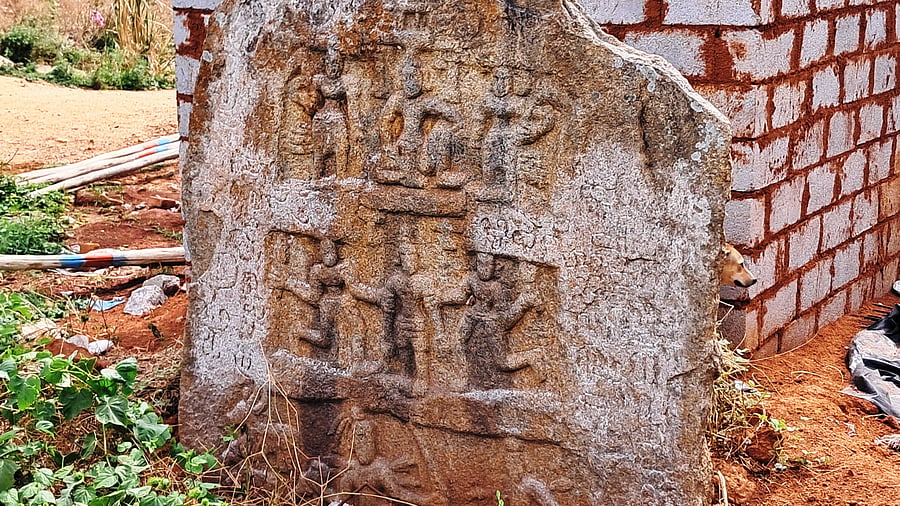
Credit: Special Arrangement
When my wife was travelling from Tumakuru towards Gubbi, she spotted a huge veeragallu (herostone) on the left side of the highway near Heggere village. I decided to visit Heggere on my next trip towards Tumakuru.
I referred to Epigraphia Carnatica, Vol 12, 1904 (EC12) to check if there are any inscription stones in this village. I found that there is a three-line inscription, labelled ‘Tm8’ in Heggere village, Tumakuru taluk. I also referred to the hardbound volume 24 of Epigraphia Carnatica, 2009 (EC24) at home, published by the Kuvempu Institute of Kannada Studies, University of Mysore.
EC24 has given a new number, ‘Tm116’ to that inscription. It mentions the same three lines as EC12. The first line begins with ‘Swasthi Shri Trilokapati’, the second line starts with the name ‘Kittamma’ followed by other names ‘Sativanna, Bannanna Adila, Yallapa’. The highly damaged third line has the name ‘Narapati’. EC24 mentions: “The purpose of this damaged record is not clear. It seems to refer to a grant by a certain Trailokapati.”
I arrived at Heggere on a late afternoon and spotted the seven-foot-high and four-foot-wide veeragallu slab near an electric transformer. It was standing majestically, but had waste of all kinds strewn around it. This appeared to be a Jain veeragallu. It had three panels.
Usually, the bottom panel depicts a battle scene, such as two men facing each other and fighting. However, here, I observed two men standing tall, both facing the front and holding shields and daggers in their hands. The middle panel shows the men being lifted to heaven by celestial nymphs, while the top one shows them arriving there. I was thrilled to find a three-line inscription in the space between the bottom and middle panel. With a long stick, I cleared the base, and there emerged animal-like carvings at the feet of the two heroes.
A second stone
When I enquired about the presence of any other relic, a shopkeeper informed me about another veeragallu behind the shops. On a site next to a building under construction, amid overgrown bushes, was this second veeragallu. It was nearly six feet tall and six feet wide. It was similar to the first veeragallu on the highway, except that the bottom panel showed a single hero holding a shield and dagger. Behind him, cattle are clearly visible, as this stone is not too weathered. The middle panel shows the hero being lifted towards heaven. He reaches heaven in the top panel. An inscription is carved, in big letters, all around these panels.
Surprisingly, in both EC editions, there is no mention of these two veeragallus or their inscriptions. Upon my return, I started searching old records, as well as reports of the Mysore Archaeological Survey (MAS). While reading in MAS 1909 about Sivamara II, a Ganga dynasty king belonging to the 8th century, I was overjoyed to see that it mentioned two veeragallus at Heggere. It stated that ‘the two veeragallus at Heggere, Tumkur taluk, which may belong to this period, record the deaths respectively of Devandera of Manniyur and of Teyilokamallayamamma....Manna’s sons in a cattle raid.’
Veeragallus were erected not only for heroes who died in battle, but also for those who died defending cattle or women in distress. Both these veeragallus depicted cattle, and they correlate with MAS 1909’s account.
I wondered if the Epigraphia editions were talking about the first inscription, because the first line on that veeragallu starts with ‘Swasthi Shri’, which is clearly readable. The word ‘Teyiloka’ is faintly decipherable, and the second line starts with what appears to be ‘Kittamma’.
While talking with villagers, I came to know of plans to widen the highway, and their fear about the future of the first veeragallu. The fate of the second veeragallu solely depends on the owner of the site where it stands as of now. I do hope the concerned individuals and authorities take care of these ancient relics that depict the local history.